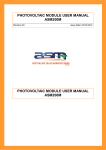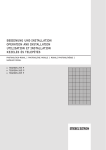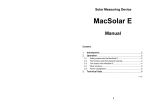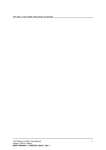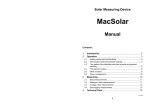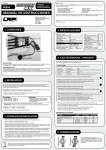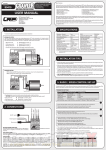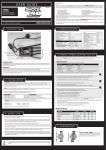Download ASM 190M user manual 1 - Australian Solar Manufacturing
Transcript
Installation | Safety instructions | Maintenance Photovoltaic Module User Manual ASM 190M Please carefully read the following installation and safety instructions. Non-compliance with these instructions may void the module warranty. Purpose of this guide This guide contains information regarding the installation and safe handling of Australian Solar Manufacturing Pty Ltd (ASM) photovoltaic modules (hereafter referred to as "modules"). All instructions should be read and understood before attempting installation. If there are any questions, please contact your dealer or ASM for further information. The installer should conform to all safety precautions in the guide when installing modules. Before installing a solar photovoltaic system, the installer should become familiar with the mechanical and electrical requirements for photovoltaic systems. Keep this guide in a safe place for future reference. 3.2 Maximum series/parallel configuration CAUTION Only solar modules of the same type and output class may be connected in series! The maximum system voltage of the modules must never be exceeded! To achieve the required system currents the modules may be connected in parallel. Only modules of the same type and voltage may be used. Ensure that the specified permitted load capacity with regard to the return current IR is not exceeded! 4. General Warning 1. Danger of death through electric shock! Touching live parts can result in death. All electrical work on the solar generator must be carried out by a qualified electrician while observing the Australian Standards, national and other regulations. Due to the series connection of the modules, voltage levels may exceed the protective extra-low voltage. Even with low solar radiation almost the full open circuit voltage can be expected in the modules. During all installation and wiring work the modules must therefore be covered or disconnected from the consumer load. Otherwise there is a risk of arc formation on lines carrying direct current. 2. Personal Protective Equipment CAUTION Mount the modules only on suitable support structures. These structures must ensure that no mechanical stresses are transferred from the building (e.g. the roof structure) to the module. The minimum distance between modules is 10 mm to allow for material expansion. The modules must be installed such that water flow (particularly along the cable) towards the cable gland at the junction box is prevented. The connection cables between the modules and towards the inverter must be installed such that the closed connectors are not permanently in water. This means, for example, that rainwater must be able to drain from U-shaped profiles. Use only the holes provided in the frame! Do not drill, nail or weld the module frames. The mounting systems recommended and shall be certified by the Australian Engineers for wind rating. Safety Protective Equipment shall be used at all times while installing solar modules. Safety Equipment shall comply with the Country’s National Safety Standards. The standard solar module is a glass/crystalline product and must not be walked on due to the risk of breakage. Protect the front and rear of the solar modules from scratching. 3. Installation Installation 4.1 Standard Mounting Each module must be secured at a minimum of four points. The frame is structurally approved for mounting on the long sides. Mounting on the short module sides must be avoided. The maximum tolerance is 100 mm. Insertion systems (U-shaped profile over the whole long/short side) are permitted under the following load conditions: Short side mounting Mounting rails only at the short edges without central support for loads up to 2400 Pa Mounting rails at the short edges with central support for loads up to 5400 Pa Long side mounting Mounting rails covering the whole length of the long edges for loads up to 5400 Pa 2400 Pa 5400 Pa 5400 Pa Only use corrosion-resistant screws. Use a torque wrench and tighten the screws with 20 Nm. 4.2 Installation Instructions Avoid point wise support and mounting of the laminates, except with mounting brackets approved by ASM. These brackets are designed for loads up to 2400 Pa. 3.1 Orientation Ideally, the front of the solar modules should face North in Southern Hemisphere and should face South in the Northern Hemisphere. The tilt angle can be calculated as follows: The ideal tilt angle should correspond to the latitude of the installation site. To achieve a good self-cleaning effect through precipitation the tilt angle of the solar modules should be at least 20° - 30°or 4/5 of latitude. Avoid any shading and heat build-up at the rear of the module. Both can lead to significant losses in yield! Otherwise the laminates must be linearly supported and fixed at both long module sides as a minimum. All support rails must be aligned such that twisting or warping of the laminates is avoided. Only use mechanical fixtures for mounting the modules. Do not use adhesives or adhesive tapes for fastening the laminates, unless they have been explicitly approved by ASM. Please ensure that the laminate edges are not permanently in water and are allowed to dry. Please note that the glass edges of the modules are particularly sensitive to impact. Follow the installation instructions for the respective mounting system. 4.3 Other data Bundling or concentration of solar radiation, for example using lenses or mirrors, is prohibited! Avoid covering the drainage holes in the module frames. Warning Artificially concentrated sunlight shall not be directed on the module or panel. This could result in damaging glass and cell or even whole module. No liability would be accepted by the manufacturer under these circumstances. For any maintenance and repair work produce a plan documenting the module installation layout, including serial number allocation and cable layout. Page 1/2 Installation | Safety instructions | Maintenance Photovoltaic Module User Manual ASM 190M Please carefully read the following installation and safety instructions. Non-compliance with these instructions may void the module warranty. 5. Electrical Connection Danger of death through electric shock! Touching live parts can result in death. Make sure the polarity is correct when connecting the modules. Reverse polarity can lead to destruction of the protective diodes. Before installing check junction box, the cables and connectors for obvious damage. For safety reasons the junction box must not be opened. Do not use the plug connectors if the plug contacts are dirty! Do not install damaged solar modules! The solar modules, and in particular the connectors and tools, must be dry during installation. In exposed locations, installation of lightning protection is recommended. If lightning protection equipment is already present, the solar modules must be integrated properly. Follow the respective current regulations. During normal conditions PV module may supply a higher current and/or voltage than specified under test conditions. For determining the voltage design values of the components, the current design values of the conductors, the ratings of the fuses and the control units connected to the solar module output, the values of Isc and Voc specified on the module should be multiplied with a factor of 1.25. The solar module is equipped with high-quality solar cables and the ZJRH plug connector system, which is protected against reverse polarity and accidental contact. The connection polarity is marked. 5.1 ZJRH – TUV certified plug connector system The ZJRH - TUV plug connector system is designed for convenient, reliable connection of individual solar generators and the Solar Inverter. 5.2 PV Cable The minimum cable cross-section should be 4 mm2. PV cables used between Module and inverter must be same and approved by TUV/Isc for PV application. 5.3 Plug connections The positive/negative coded connectors are marked with polarity symbols and a coloured ring (blue = negative, red = positive. They are equipped with coding ribs for assignment, which ensure that only connectors of the same polarity can be connected to each other. 5.4 Connecting socket and plug: The system is only correctly locked if the locking hooks are recessed flush in the mating piece. 5.5 Maximum Parallel Connected Modules Maximum number of array in parallel is 3 and additional array would need circuit protective devices installed to protect cable rating – 4mm. 5.6 Type of Protective Devices 10A HRC cartridge fuses or 500V DC double pole circuit breaker. CAUTION The plug connectors must not be disconnected or connected under load current! They may be connected and disconnected while voltage is present. Release the locking mechanism by pressing on the ribbing of the locking hooks and pulling the connectors apart. 5.7 Application class ASM Modules conform to application class A according to the international safety standard IEC EN 61730 and IEC EN 61215 and therefore meet the requirements of protection class II. ASM Modules can be used in systems with a DC voltage in excess of 120 VDC. 5.8 Earthing of the modules All module frames and mounting racks must be properly grounded in accordance with the National Electrical Code (Australian Standards) Proper grounding is achieved by connecting the module frame(s) and structural members contiguously one to another using a suitable grounding conductor. The grounding conductor or strap may be copper, copper alloy, or other material acceptable for use as an electrical conductor per NEC. The grounding conductor must then make a connection to earth using a suitable earth ground electrode. Attach a separate conductor to one of the 4mm diameter grounding holes marked 'GR' on the module frame with a bolt and nut that incorporates an external tooth washer. This is to ensure positive electrical contact with the frame. The rack must also be grounded unless they are mechanically connected by nuts and bolts to the grounded ASM modules. The array frame shall be grounded in accordance with NEC Art250. 6. Maintenance and Cleaning Check your solar generator approx. every three years for soiling. This occurs especially on the lower edge of the modules and forms a haze that cannot be washed off even by heavy rain. In the event of significant dirt build-up we recommend cleaning the glass surface. Use plenty of lukewarm water and a soft brush. This prevents loss of yield. CAUTION Do not use strong cleaning agents and metallic objects, in order to avoid damage to the hardened glass surface! Occasionally check the cables for damage, corrosion and make sure they are secure. 7. Shutting down the system Completely cover system modules with an opaque material to prevent electricity from being generated while disconnecting conductors. Disconnect system from all power sources in accordance with instructions for all other components used in the system. The system should now be out of operation and can be dismantled. In doing so, observe the all safety instructions as applicable to installation. 8. MODULE SPECIFICATION Maximum Power (Pm)* Cell Single No. of Cells and Connections Open Circuit Voltage (Voc) Maximum Power Voltage (Vpm) Short Circuit Current (Isc) Maximum Power Current (Ipm) Minimum Power (Pm)* Encapsulated Solar Cell Efficiency (ηc) Maximum System Voltage Series Fuse Rating Type of Output Terminal Cell Outline Dimensions 190W Mono Crystal silicon 72 in series 45.026V 36.03V 5.639A 5.315A 184.3W 17.25% 1000VDC 10A Lead Wire with ZJRH Connector 125mm x 125mm +/- 0.5mm Electrical Characteristics of Cell Light Intensity Spectrum Temperature Measurement Method Standard intensity 1000 W/sqm AM1.5 spectrum 25 °C IEC904-1 Note: Test condition is STC Irradiance 1000W/squm with AM1.5 spectrum, cell temperature 25 °C, Test method according to IEC904-1. Tolerance Efficiency 3% rel. 9. Disclaimer of liability Because the use of this manual and the conditions or methods of installation, operation, use and maintenance of photovoltaic products are beyond ASM's control, ASM does not accept responsibility and expressly disclaims liability for loss, damage, or expense arising out of or in any way connected with such installation, operation, use or maintenance. No responsibility is assumed by ASM for any infringement of patents or other rights of third parties, which may result from use of the PV product. No license is granted by implication or otherwise under any patent or patent rights. The information in this manual is based on ASM's knowledge and experience and is believed to be reliable, but such information including product specification (without limitations) and suggestions does not constitute a warranty, expressed or implied. ASM reserves the right to change the manual, the product, the specifications, or product information sheets without prior notice. Information about manufacturer: Australian Solar Manufacturing Pty Ltd 2/37 Rimfire Drive Hallam, Victoria 3803 Australia P: 61 3 8786 3461 F: 61 3 8786 3459 W: www.australiansolarmanufacturing.com.au Please consult your dealer or the manufacturer concerning the warranty of your modules. If you have any further questions, your dealer will gladly assist you. Subject to technical modifications without notice.. 2010 © ASM www.australiansolarmanufacturing.com.au/ | 2010 © ASM Page 2/2


